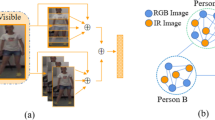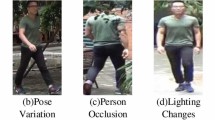Abstract
Visible-infrared person re-identification (VI-ReID) is a challenging cross-modality pedestrian retrieval problem. Due to the large intra-class variations and cross-modality discrepancy with large amount of sample noise, it is difficult to learn discriminative part features. Existing VI-ReID methods instead tend to learn global representations, which have limited discriminability and weak robustness to noisy images. In this paper, we propose a novel dynamic dual-attentive aggregation (DDAG) learning method by mining both intra-modality part-level and cross-modality graph-level contextual cues for VI-ReID. We propose an intra-modality weighted-part attention module to extract discriminative part-aggregated features, by imposing the domain knowledge on the part relationship mining. To enhance robustness against noisy samples, we introduce cross-modality graph structured attention to reinforce the representation with the contextual relations across the two modalities. We also develop a parameter-free dynamic dual aggregation learning strategy to adaptively integrate the two components in a progressive joint training manner. Extensive experiments demonstrate that DDAG outperforms the state-of-the-art methods under various settings.
Access this chapter
Tax calculation will be finalised at checkout
Purchases are for personal use only
Similar content being viewed by others
References
Bai, S., Tang, P., Torr, P.H., Latecki, L.J.: Re-ranking via metric fusion for object retrieval and person re-identification. In: CVPR, pp. 740–749 (2019)
Basaran, E., Gokmen, M., Kamasak, M.E.: An efficient framework for visible-infrared cross modality person re-identification. arXiv preprint arXiv:1907.06498 (2019)
Cao, J., Pang, Y., Han, J., Li, X.: Hierarchical shot detector. In: ICCV, pp. 9705–9714 (2019)
Chen, B., Deng, W., Hu, J.: Mixed high-order attention network for person re-identification. In: ICCV, pp. 371–381 (2019)
Chen, D., et al.: Improving deep visual representation for person re-identification by global and local image-language association. In: Ferrari, V., Hebert, M., Sminchisescu, C., Weiss, Y. (eds.) ECCV 2018. LNCS, vol. 11220, pp. 56–73. Springer, Cham (2018). https://doi.org/10.1007/978-3-030-01270-0_4
Chen, Z., Badrinarayanan, V., Lee, C.Y., Rabinovich, A.: GradNorm: gradient normalization for adaptive loss balancing in deep multitask networks. In: ICML, pp. 793–802 (2018)
Dai, P., Ji, R., Wang, H., Wu, Q., Huang, Y.: Cross-modality person re-identification with generative adversarial training. In: IJCAI, pp. 677–683 (2018)
Fang, P., Zhou, J., Roy, S.K., Petersson, L., Harandi, M.: Bilinear attention networks for person retrieval. In: ICCV, pp. 8030–8039 (2019)
Feng, Z., Lai, J., Xie, X.: Learning modality-specific representations for visible-infrared person re-identification. IEEE TIP 29, 579–590 (2020)
Gong, Y., Zhang, Y., Poellabauer, C., et al.: Second-order non-local attention networks for person re-identification. In: ICCV, pp. 3760–3769 (2019)
Hao, Y., Wang, N., Li, J., Gao, X.: HSME: hypersphere manifold embedding for visible thermal person re-identification. In: AAAI, pp. 8385–8392 (2019)
He, K., Zhang, X., Ren, S., Sun, J.: Deep residual learning for image recognition. In: CVPR, pp. 770–778 (2016)
He, R., Wu, X., Sun, Z., Tan, T.: Learning invariant deep representation for NIR-VIS face recognition. In: AAAI, pp. 2000–2006 (2017)
Hou, R., Ma, B., Chang, H., Gu, X., Shan, S., Chen, X.: Interaction-and-aggregation network for person re-identification. In: CVPR, pp. 9317–9326 (2019)
Hou, R., Ma, B., Chang, H., Gu, X., Shan, S., Chen, X.: VRSTC: occlusion-free video person re-identification. In: CVPR, pp. 7183–7192 (2019)
Huang, D.A., Frank Wang, Y.C.: Coupled dictionary and feature space learning with applications to cross-domain image synthesis and recognition. In: ICCV, pp. 2496–2503 (2013)
Jingya, W., Xiatian, Z., Shaogang, G., Wei, L.: Transferable joint attribute-identity deep learning for unsupervised person re-identification. In: CVPR, pp. 2275–2284 (2018)
Leng, Q., Ye, M., Tian, Q.: A survey of open-world person re-identification. IEEE TCSVT 30(4), 1092–1108 (2019)
Li, D., Wei, X., Hong, X., Gong, Y.: Infrared-visible cross-modal person re-identification with an X modality. In: AAAI, pp. 4610–4617 (2020)
Li, S., Bak, S., Carr, P., Wang, X.: Diversity regularized spatiotemporal attention for video-based person re-identification. In: CVPR, pp. 369–378 (2018)
Li, S., Xiao, T., Li, H., Yang, W., Wang, X.: Identity-aware textual-visual matching with latent co-attention. In: ICCV, pp. 1890–1899 (2017)
Li, W., Zhu, X., Gong, S.: Harmonious attention network for person re-identification. In: CVPR, pp. 2285–2294 (2018)
Lin, J.W., Li, H.: HPILN: a feature learning framework for cross-modality person re-identification. arXiv preprint arXiv:1906.03142 (2019)
Liu, C.T., Wu, C.W., Wang, Y.C.F., Chien, S.Y.: Spatially and temporally efficient non-local attention network for video-based person re-identification. In: BMVC (2019)
Liu, H., Cheng, J.: Enhancing the discriminative feature learning for visible-thermal cross-modality person re-identification. arXiv preprint arXiv:1907.09659 (2019)
Liu, X., et al.: HydraPlus-Net: attentive deep features for pedestrian analysis. In: ICCV, pp. 350–359 (2017)
Luo, H., et al.: A strong baseline and batch normalization neck for deep person re-identification. arXiv preprint arXiv:1906.08332 (2019)
Mudunuri, S.P., Venkataramanan, S., Biswas, S.: Dictionary alignment with re-ranking for low-resolution NIR-VIS face recognition. IEEE TIFS 14(4), 886–896 (2019)
Nguyen, D.T., Hong, H.G., Kim, K.W., Park, K.R.: Person recognition system based on a combination of body images from visible light and thermal cameras. Sensors 17(3), 605 (2017)
Pang, M., Cheung, Y.M., Shi, Q., Li, M.: Iterative dynamic generic learning for face recognition from a contaminated single-sample per person. IEEE TNNLS (2020)
Pang, M., Cheung, Y.M., Wang, B., Lou, J.: Synergistic generic learning for face recognition from a contaminated single sample per person. IEEE TIFS 15, 195–209 (2019)
Peng, C., Wang, N., Li, J., Gao, X.: Re-ranking high-dimensional deep local representation for NIR-VIS face recognition. IEEE TIP 28, 4553–4565 (2019)
Santurkar, S., Tsipras, D., Ilyas, A., Madry, A.: How does batch normalization help optimization? In: NeurIPS, pp. 2483–2493 (2018)
Sarfraz, M.S., Stiefelhagen, R.: Deep perceptual mapping for cross-modal face recognition. Int. J. Comput. Vision 122(3), 426–438 (2017)
Shao, R., Lan, X., Li, J., Yuen, P.C.: Multi-adversarial discriminative deep domain generalization for face presentation attack detection. In: CVPR, pp. 10023–10031 (2019)
Shao, R., Lan, X., Yuen, P.C.: Joint discriminative learning of deep dynamic textures for 3D mask face anti-spoofing. IEEE TIFS 14(4), 923–938 (2018)
Si, J., et al.: Dual attention matching network for context-aware feature sequence based person re-identification. In: CVPR, pp. 5363–5372 (2018)
Song, G., Chai, W.: Collaborative learning for deep neural networks. In: NeurIPS, pp. 1837–1846 (2018)
Sun, Y., et al.: Perceive where to focus: learning visibility-aware part-level features for partial person re-identification. In: CVPR, pp. 393–402 (2019)
Sun, Y., Zheng, L., Yang, Y., Tian, Q., Wang, S.: Beyond part models: person retrieval with refined part pooling (and a strong convolutional baseline). In: Ferrari, V., Hebert, M., Sminchisescu, C., Weiss, Y. (eds.) ECCV 2018. LNCS, vol. 11208, pp. 501–518. Springer, Cham (2018). https://doi.org/10.1007/978-3-030-01225-0_30
Tay, C.P., Roy, S., Yap, K.H.: AANet: attribute attention network for person re-identifications. In: CVPR, pp. 7134–7143 (2019)
Vaswani, A., et al.: Attention is all you need. In: NeurIPS, pp. 5998–6008 (2017)
Veličković, P., Cucurull, G., Casanova, A., Romero, A., Lio, P., Bengio, Y.: Graph attention networks. In: ICLR (2018)
Wang, G., Zhang, T., Cheng, J., Liu, S., Yang, Y., Hou, Z.: RGB-infrared cross-modality person re-identification via joint pixel and feature alignment. In: ICCV, pp. 3623–3632 (2019)
Wang, G., Yuan, Y., Chen, X., Li, J., Zhou, X.: Learning discriminative features with multiple granularities for person re-identification. In: ACM MM, pp. 274–282. ACM (2018)
Wang, N., Gao, X., Sun, L., Li, J.: Bayesian face sketch synthesis. IEEE TIP 26(3), 1264–1274 (2017)
Wang, X., Girshick, R., Gupta, A., He, K.: Non-local neural networks. In: CVPR, pp. 7794–7803 (2018)
Wang, Z., Wang, Z., Zheng, Y., Wu, Y., Zeng, W., Satoh, S.: Beyond intra-modality: a survey of heterogeneous person re-identification. In: IJCAI (2020)
Wang, Z., Wang, Z., Zheng, Y., Chuang, Y.Y., Satoh, S.: Learning to reduce dual-level discrepancy for infrared-visible person re-identification. In: CVPR, pp. 618–626 (2019)
Wu, A., Zheng, W.s., Yu, H.X., Gong, S., Lai, J.: RGB-infrared cross-modality person re-identification. In: ICCV, pp. 5380–5389 (2017)
Wu, X., Huang, H., Patel, V.M., He, R., Sun, Z.: Disentangled variational representation for heterogeneous face recognition. In: AAAI, pp. 9005–9012 (2019)
Wu, X., Song, L., He, R., Tan, T.: Coupled deep learning for heterogeneous face recognition. In: AAAI, pp. 1679–1686 (2018)
Xu, K., et al.: Show, attend and tell: neural image caption generation with visual attention. In: ICML, pp. 2048–2057 (2015)
Yang, W., Huang, H., Zhang, Z., Chen, X., Huang, K., Zhang, S.: Towards rich feature discovery with class activation maps augmentation for person re-identification. In: CVPR, pp. 1389–1398 (2019)
Yao, H., Zhang, S., Hong, R., Zhang, Y., Xu, C., Tian, Q.: Deep representation learning with part loss for person re-identification. IEEE TIP 28(6), 2860–2871 (2019)
Ye, M., Lan, X., Leng, Q., Shen, J.: Cross-modality person re-identification via modality-aware collaborative ensemble learning. IEEE Trans. Image Process. (TIP) 29, 9387–9399 (2020)
Ye, M., Lan, X., Li, J., Yuen, P.C.: Hierarchical discriminative learning for visible thermal person re-identification. In: AAAI, pp. 7501–7508 (2018)
Ye, M., Lan, X., Wang, Z., Yuen, P.C.: Bi-directional center-constrained top-ranking for visible thermal person re-identification. IEEE TIFS 15, 407–419 (2020)
Ye, M., Shen, J., Lin, G., Xiang, T., Shao, L., Hoi, S.C.H.: Deep learning for person re-identification: a survey and outlook. arXiv preprint arXiv:2001.04193 (2020)
Ye, M., Shen, J., Shao, L.: Visible-infrared person re-identification via homogeneous augmented tri-modal learning. IEEE TIFS 16, 728–739 (2020)
Ye, M., Shen, J., Zhang, X., Yuen, P.C., Chang, S.F.: Augmentation invariant and instance spreading feature for softmax embedding. IEEE TPAMI (2020)
Zeng, Z., Wang, Z., Wang, Z., Zheng, Y., Chuang, Y.Y., Satoh, S.: Illumination-adaptive person re-identification. IEEE TMM (2020)
Zhang, X., Yu, F.X., Karaman, S., Zhang, W., Chang, S.F.: Heated-up softmax embedding. arXiv preprint arXiv:1809.04157 (2018)
Zhang, X., et al.: AlignedReID: surpassing human-level performance in person re-identification. arXiv preprint arXiv:1711.08184 (2017)
Zhang, Y., Li, K., Li, K., Zhong, B., Fu, Y.: Residual non-local attention networks for image restoration. In: ICLR (2019)
Zhao, L., Li, X., Zhuang, Y., Wang, J.: Deeply-learned part-aligned representations for person re-identification. In: ICCV, pp. 3219–3228 (2017)
Zheng, F., et al.: Pyramidal person re-identification via multi-loss dynamic training. In: CVPR, pp. 8514–8522 (2019)
Zheng, L., Shen, L., Tian, L., Wang, S., Wang, J., Tian, Q.: Scalable person re-identification: a benchmark. In: ICCV, pp. 1116–1124 (2015)
Author information
Authors and Affiliations
Corresponding author
Editor information
Editors and Affiliations
Rights and permissions
Copyright information
© 2020 Springer Nature Switzerland AG
About this paper
Cite this paper
Ye, M., Shen, J., J. Crandall, D., Shao, L., Luo, J. (2020). Dynamic Dual-Attentive Aggregation Learning for Visible-Infrared Person Re-identification. In: Vedaldi, A., Bischof, H., Brox, T., Frahm, JM. (eds) Computer Vision – ECCV 2020. ECCV 2020. Lecture Notes in Computer Science(), vol 12362. Springer, Cham. https://doi.org/10.1007/978-3-030-58520-4_14
Download citation
DOI: https://doi.org/10.1007/978-3-030-58520-4_14
Published:
Publisher Name: Springer, Cham
Print ISBN: 978-3-030-58519-8
Online ISBN: 978-3-030-58520-4
eBook Packages: Computer ScienceComputer Science (R0)




